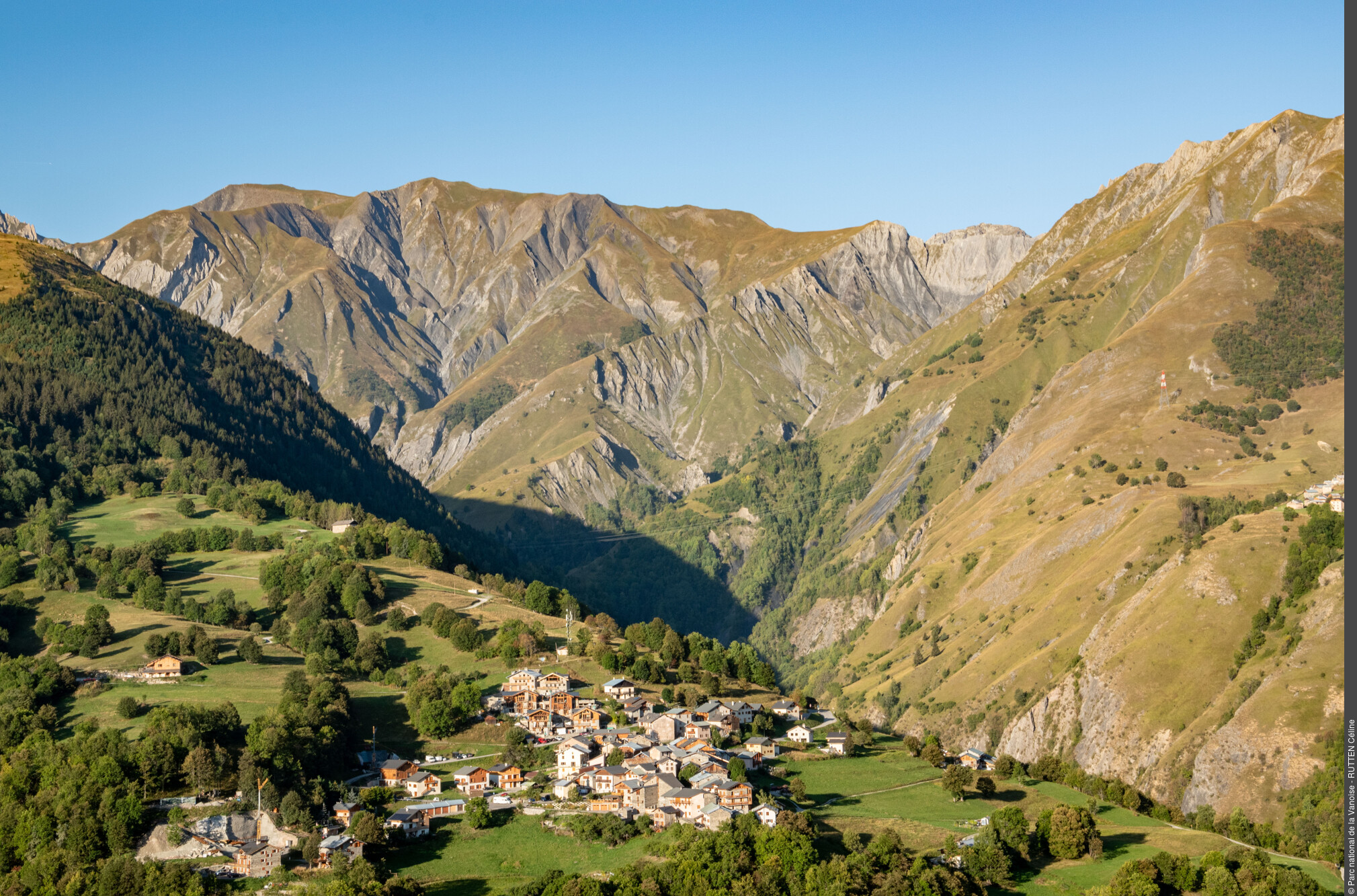
Tour of Planlebon in the Encombres Valley
""I remember one cool early morning when my steps took me to Planlebon. Just before crossing the Encombres torrent over the footbridge, the robin came to greet me. It was at the foot of the chapel that I decided to rest, taking my time to immerse myself in the setting and imagine how life here used to be in this small isolated mountain hamlet. Céline Rutten, Vanoise National Park Ranger
"Description
From the car park, take the slightly uphill grassy path. This path becomes narrower and enters the undergrowth. Leave the trail on the left and go down into the forest. The path winds steeply to a footbridge. Cross this footbridge and go up on the other slope of the gorges as far as the village of Planlebon. At the top left of the village, follow the trail that runs along the slope. After crossing two streams and a steeper section, walk through the undergrowth. The valley then widens and you go down to the Pont des Priots. Continue along the left bank of the torrent until you reach another bridge, cross it and climb the bends to reach “Route des Encombres”. Follow the road until Refuge de Gittamelon. From the Refuge, take the path leading to Rocher Roux. Then go down, cross the vehicle track and turn off the path that leads to Priots and ends at a stony track. After the last house, turn left onto the grassy path that runs along the valley. At the fork in the path, choose the descending path. Leave this path at the next turn to take a right onto the undergrowth trail. This then joins the departure path and car park.
- Departure : Frachettes car park
- Arrival : Frachettes car park
- Towns crossed : LES BELLEVILLE
Forecast
Altimetric profile
Recommandations
Be particularly careful on the trail overlooking the torrent after passing the village of Planlebon.
It is possible to shorten the hike by taking the Pont des Priots (1,535m in altitude) to reach the village of the same name and finally the departure car park.
Transport
Rail connection to Moûtiers, Information: www.voyages-sncf.com.Then transport by coach to Saint-Martin-de-Belleville, information www.transavoie.com . Free shuttle buses between Val Thorens and Saint-Martin-de-Belleville, information:: Transdev Savoie. Departure for the hike approximately 3 km from the village centre.
"Access and parking
From Moutiers take the D117 in the direction of the “Vallée des Belleville”. Pass Saint-Jean-de-Belleville and continue until the administrative centre of Saint-Martin-de-Belleville. At the entrance to the administrative centre, take the small road on the right leading to Châtelard. At the entrance to the hamlet of Châtelard, turn left in the direction of the ""Vallée des Emcombres"" and follow this road to the signpost for Frachettes car park. Park on the right below.
"Parking :
Accessibility
No special amenities
- Emergency number :
- 114
5 points of interest
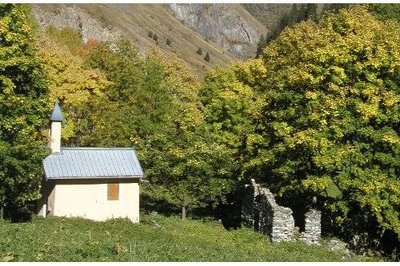
Le hameau de Planlebon - PNV  History
HistoryThe hamlet of Planlebon
In the 18th century, as the population of the Belleville Valley continued to grow, even the most remote villages became permanent habitats and all usable plots were cultivated. Consequently, the hamlet of Planlebon had 36 inhabitants in 1773. They spent their winters cut off from the world. The Encombres valley takes its name from the heavy avalanche activity in the area. The archives hold the memory of an avalanche that submerged the inhabitants of the village as they went to Mass in the administrative centre. After 1850, the exodus depopulated the mountains and the isolated villages were abandoned. The hamlet of La Gittaz (pronounced La Gitte), located at the entrance of the valley, experienced the same evolution as Planlebon. Sunnier and accessible by vehicle, this village has been restored.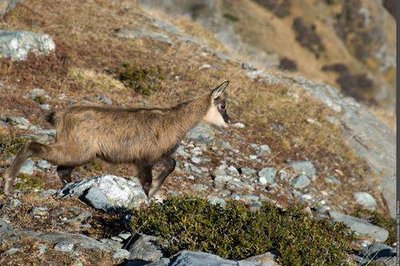
Cabri de Chamois. (PNV CP) - MELE Stéphane  Fauna
FaunaThe chamois
From the crests to the torrent, the left bank of the Encombres valley is part of a hunting reserve which brings together about 1,300 chamois as well as rœ, deer and ibex. Susceptible to avalanches, this valley naturally protects them from winter disturbances which would be fatal to them in this time of rest. The animals occupy the southern slopes during the cold period as the snow dœsn’t hold there for long. On these sun-exposed slopes, the avalanches quickly pull out the dry grass on which they feed. In the spring, the greenery attracts them near to the ruins of Planlebon. They then return to the heights where they keep a lower profile, using the summer to fatten up.</ P>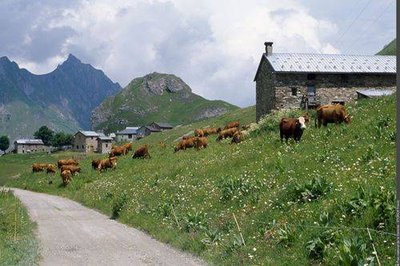
Vaches en pâture sur la Chaudanne (PNV PO) - admin  Pastoralism
PastoralismGittamelon
Sheep, goats and cows... Herdsmen, cheese makers, refuge keepers, ... the Encombres valley is definitely always lively! Follow the herds by the sound of their cowbells, these bells of varying size hang around the animal’s neck and make them easier to find. The Refuge de Gittamelon welcomes hikers for short coffee breaks, a meal or an overnight stay. These are the Aiguilles de la Mœndaz (2,697m) which will wish you good night.

Conservatoire de l'abeille noire - aptv_redac  Fauna
FaunaBlack Bee Conservatory
The black bee (Apis mellifera mellifera) is a subspecies of the domestic bee. Savoie’s ecotype has adapted to the climate and local flora and is used by the Valley’s apiarists. The creation of a black bee conservatory in the Vallée des Encombres in April 2016 included setup of breeding apiaries ensuring that young queens were only fertilised by males of the same ecotype. There’s a breeding apiary consisting of small-size hives on the spot where the trail leaves the Route des Encombres and takes you down to Les Priots. The power line that runs just above them doesn'tt seem to disturb their inhabitants.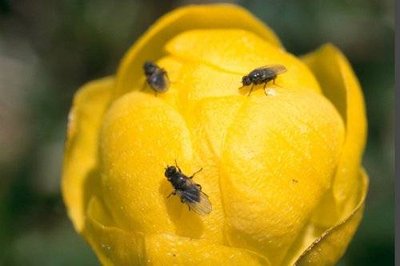
La mouche du Trolle - PNV  Flora
FloraThe globeflower fly
Every spring, the cycle begins again: the meadow is adorned with the most beautiful flowers! On the bright corollas, insects are busy: butterflies, flies and bees fervently gather pollen. But on the splendid golden globeflower, jealously closed in on themselves, the contenders are rare. Only flies of the Chiastocheta genus can be creep into the globes to collect nectar and at the same time load themselves with pollen. But, hidden from view, the fly also lays its eggs in the flowers’ ovules, so that the larvae, as they develop, devour the budding seeds. Fortunately, the few sparse seeds will give other globes.
